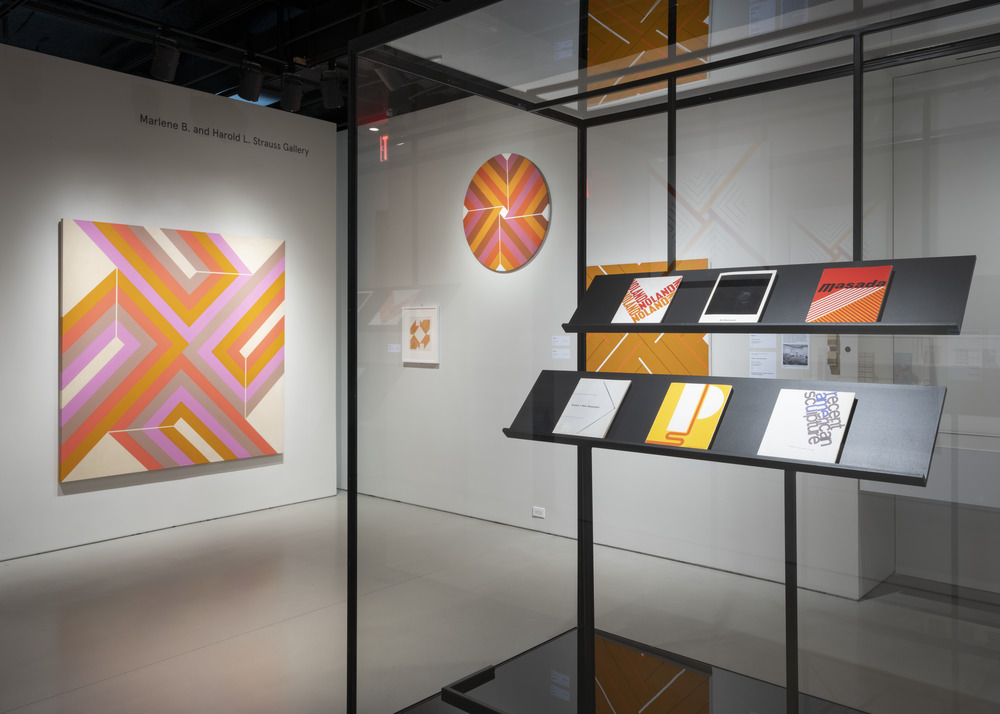Scenes from the Collection: Elaine Lustig Cohen
The Jewish Museum, New York
August 17, 2018 to August 18, 2019
Co-curated with Prem Krishnamurthy and Shira Backer
One of seven sections that make up the Jewish Museum’s third floor collection exhibition, Scenes from the Collection, this exhibition focused on six Jewish Museum catalogues whose covers and interiors were playfully and ingeniously designed by Elaine Lustig Cohen (1927-2016). Over six decades of practice, Lustig Cohen moved between diverse activities including art-making and rare book dealing, as well as design. This exhibition brings together the public sphere of her graphic design work and the private vision of her paintings, highlighting a pivotal moment and a singular voice in American visual culture of the twentieth century.
Lustig Cohen began her career in the mid-1950s, extending the vocabulary of European modernism into an American context as a designer for a clientele of significant publishers, architects, and cultural institutions. From 1962 to 1967, she helped shape the Jewish Museum’s institutional identity by directing the design of printed ephemera and catalogues for a program of art exhibitions that was among the most progressive in the nation, including the historic Primary Structures: Younger American and British Sculptors (1966) organized by Kynaston McShine. During the same period, Lustig Cohen developed a hard-edged style as a painter. Employing a bold formal language of geometric shapes and vibrant solid colors, Lustig Cohen’s paintings relate to her design work as well as the contemporaneous practices of other artists who strove to dissolve the barriers between painting and objecthood. Seen in this light, her work suggests that the lineage of post-painterly abstraction — the term often used to describe the 1960s work of artists such as Frank Stella, Ellsworth Kelly, and Morris Louis — should be expanded to include not only post-war artistic movements such as Abstract Expressionism but also post-war graphic design. At the same time, Lustig Cohen’s ephemera and exhibition catalogues offer a window into a moment in the Jewish Museum’s history that was as lively and colorful as her designs.
The exhibition includes six Jewish Museum exhibition catalogues: Toward a New Abstraction (1963); Recent American Sculpture (1964); Kenneth Noland (1965); Primary Structures (1966); Ad Reinhardt (1966); and Masada (1967). Also included are a selection of paintings from the 1960s and 1970s; approximately ten of Lustig Cohen’s typographic, abstract, and photographic book jacket designs that show her unique style and attention to content; and graphic pieces such as posters, bags, and invitations for the Jewish Museum.
August 17, 2018 to August 18, 2019
Co-curated with Prem Krishnamurthy and Shira Backer
One of seven sections that make up the Jewish Museum’s third floor collection exhibition, Scenes from the Collection, this exhibition focused on six Jewish Museum catalogues whose covers and interiors were playfully and ingeniously designed by Elaine Lustig Cohen (1927-2016). Over six decades of practice, Lustig Cohen moved between diverse activities including art-making and rare book dealing, as well as design. This exhibition brings together the public sphere of her graphic design work and the private vision of her paintings, highlighting a pivotal moment and a singular voice in American visual culture of the twentieth century.
Lustig Cohen began her career in the mid-1950s, extending the vocabulary of European modernism into an American context as a designer for a clientele of significant publishers, architects, and cultural institutions. From 1962 to 1967, she helped shape the Jewish Museum’s institutional identity by directing the design of printed ephemera and catalogues for a program of art exhibitions that was among the most progressive in the nation, including the historic Primary Structures: Younger American and British Sculptors (1966) organized by Kynaston McShine. During the same period, Lustig Cohen developed a hard-edged style as a painter. Employing a bold formal language of geometric shapes and vibrant solid colors, Lustig Cohen’s paintings relate to her design work as well as the contemporaneous practices of other artists who strove to dissolve the barriers between painting and objecthood. Seen in this light, her work suggests that the lineage of post-painterly abstraction — the term often used to describe the 1960s work of artists such as Frank Stella, Ellsworth Kelly, and Morris Louis — should be expanded to include not only post-war artistic movements such as Abstract Expressionism but also post-war graphic design. At the same time, Lustig Cohen’s ephemera and exhibition catalogues offer a window into a moment in the Jewish Museum’s history that was as lively and colorful as her designs.
The exhibition includes six Jewish Museum exhibition catalogues: Toward a New Abstraction (1963); Recent American Sculpture (1964); Kenneth Noland (1965); Primary Structures (1966); Ad Reinhardt (1966); and Masada (1967). Also included are a selection of paintings from the 1960s and 1970s; approximately ten of Lustig Cohen’s typographic, abstract, and photographic book jacket designs that show her unique style and attention to content; and graphic pieces such as posters, bags, and invitations for the Jewish Museum.





